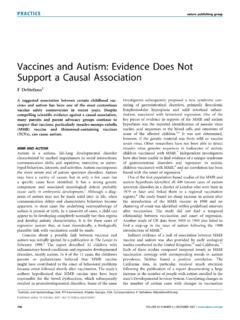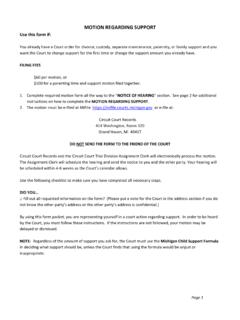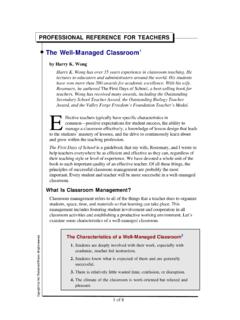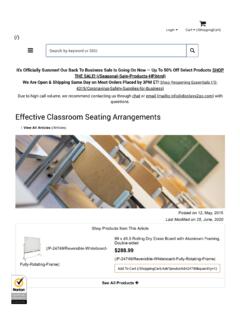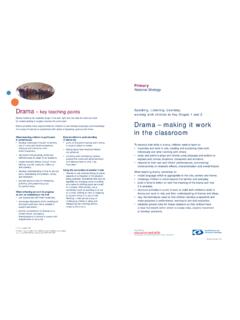Transcription of ADHD: Classroom Interventions - miOttawa
1 ADHD: Classroom InterventionsBY STEPHEN E. BROCK, PHD, NCSP; BETHANY GROVE, EDS; & MELANIE SEARLS, EDS,California State University,SacramentoAttention deficit hyperactivity disorder (ADHD) is one of the most commonchildhood behavior 2006 National Health Interview Survey indicated that 7% of children ages 3 17 have at some pointbeen diagnosed with ADHD (Bloom & Cohen, 2007). Combined with this high prevalence is the fact thatADHD s core symptoms of inattention, hyperactivity, and impulsivity areassociated with a variety ofschool adjustment challenges. It is not surprising that these students are at risk for school failure andrequire behavioral Interventions to promote school APPROACHES TO BEHAVIOR INTERVENTIONB efore offering Interventions for specific ADHD challenges, it is important to acknowledge that, whilethese students do have a core set of common difficulties, this group is verydiverse.
2 Instead of focusingonly on ADHD symptoms, intervention should begin by identifying specificchallenging behaviors. Next,identify alternative desired behaviors that would preclude the occurrence of the challenging behaviors(behaviors that are incompatible with the undesired behaviors). Keep both sets of behaviors in need to not only make clear to students what behavior is unacceptable, but also what behavioris that intervention plans are based on a functional assessment of behavior. Identify antecedentsand consequences of both the challenging and desirable behaviors. Analysis of antecedents will suggestadjustments to the Classroom setting that can set up the student for success ( , reducing the amount oftime spent in specific challenging situations), while analysis of consequences will identify thoseenvironmental conditions that reinforce behavior ( , escaping challenging situations).
3 The function ofthe problem behavior should guide Interventions . For example, if the behavior is maintained by negativereinforcement ( , avoidance of an undesired task), the intervention should ensure that this goal is notobtained by the problem behavior. At the same time, the intervention should teach the student that thedesirable behavior is a more effective and efficient way of obtaining the desired behavioral AND INSTRUCTIONAL CONSIDERATIONSC lassroom environmental changes can be helpful in reducing problematic behaviors and learningdifficulties. The Interventions discussed below might be thought of assetting up the student with ADHD specific citations in support of these Interventions , see Brock, Jimerson, and Hansen (2009).Task DurationGiven the short attention span of students with ADHD, academic assignments should be brief, withimmediate feedback regarding accuracy.
4 For example, long projects can bebroken up into smaller parts. Itcan also be helpful to allow students to take breaks during long periods of class DifficultyStudents with ADHD are more likely to give up and become frustrated when given an academic task thatexceeds their instructional level. They also tend to become bored and inattentive with simple task difficulty ( , matching difficulty to the student s skill level) is a way to engage studentswith ADHD and to help them avoid frustration. Some students with ADHD may also benefit from startingwith easier tasks and slowly progressing to more difficult tasks as their confidence InstructionAttention and on-task behavior can be improved when the student with ADHD is engaged in teacher-directed activities instead of independent seatwork. Teaching note-taking strategies increases the benefitsHelping Children at Home and School III|S8H5 1of direct instruction and has been shown to significantlyimprove on-task behavior, scores on assignments, andcomprehension.
5 Students with ADHD may also benefitfrom explicit direct instruction on attention ( , atten-tion training sessions). Skills practiced in these sessionscan include avoiding irrelevant cues ( , other studentstalking) and selectively attending to important material( , the teacher s instruction).Peer TutoringPeer tutoring has been shown to be effective insupporting academic and behavioral gains amongstudents with ADHD. It is recommended that peertutors be of the same gender as the student with ADHDand have higher academic and better behavioral highest academic gains in peer tutoring situationsare made when students are presented with challengingmaterial and when teacher feedback is frequent. As littleas 20 minutes per day of peer tutoring has been found toresult in significant increases in on-task Peer TutoringStudents with ADHD who have participated in class-wide peer tutoring have been reported to demonstrateincreased on-task behavior and improved accuracy onacademic tasks.
6 Each student plays the role of a tutorand a tutee, and teachers are required to carefullymonitor the process. This intervention involves firstproviding students with ADHD with instruction on howto be an effective tutor and then giving them scripts ofacademic materials. Tutors give immediate feedback andpoints are awarded for correct that the on-task behavior of students with ADHD typically worsens as the academic day progresses, it isrecommended that critical instruction be provided in themorning. During the afternoon, when problem-solvingskills tend to be especially poor, more active, nonaca-demic activities can be scheduled. Further, preferredactivities can be scheduled after nonpreferred activitiesto provide an incentive to complete challenging the novelty and interest level of tasks ( ,color, shape, texture) reduces activity level, increasesattention, and improves the overall performance ofstudents with attention problems.
7 Teachers can usenovelty in the Classroom by bolding important elementsof written directions and using brightly colored paper,animation, or even different intonations when givinginstructions or teaching a lesson. Students with ADHD respond positively to the novelty provided by films,models, and skits. It is also important to minimizeassigning repetitive tasks for students with ADHD, asthese increase off-task and OrganizationStudents with ADHD respond positively to structure andpredictability. They can benefit from the use of a dailyschedule and maintaining a consistent day-to-dayroutine. It may also be helpful to give them advancenotice of changes in the class routine. Lessons them-selves can be carefully structured and important pointsclearly identified. For example, providing a lecture outlineis a helpful aid that increases memory of main with ADHD perform better on memory taskswhen material is meaningfully structured for Reminders and Visual CuesThe rules given to students with ADHD should be welldefined, specific, frequently reinforced, and associatedwith clear consequences.
8 Because relying on students memory of rules is insufficient, visual rule remindersshould be placed throughout the Classroom . It is alsohelpful if rules are reviewed before activity transitionsand following school breaks. Teaching students self-monitoring skills using visual cues has been shown toimprove selective and sustained attention and languagewhile at the same time reducing impulsivity. Suchinstruction can be facilitated by providing students witha list of questions to run through when starting a newassignment, such as: What is the problem? What ismy plan? Am I following my plan? and How did Ido? Pacing of WorkWhen possible, allow students with ADHD to set theirown pace. The intensity of problematic ADHD behaviorsis lessened when work is and Direct InstructionsStudents with ADHD often have difficulty followingdirections with many steps.
9 Directions should be short,specific, and direct. By using fewer and more directwords to explain assignments, teachers can increase theunderstanding and engagement of students with ensure understanding, students with ADHD can beasked to rephrase directions in their own should be prepared to repeat directionsfrequently and recognize that these students may oftenmiss what was said due to the inattention associatedwith their students a choice of activities can help toreduce disruptive behaviors and increase on-task beha-vior and task completion. This accommodation mightS8H5 2|ADHD involve giving a student a list of possible tasks tocomplete and letting the student choose what to work onfirst. Choices might include working on either a math or alanguage arts assignment for 15 minutes before beingrequired to switch to the other subject.
10 This strategy ismost effective when it is used in combination with otherbehavioral Physical MovementStudents with hyperactive symptoms may have difficultysitting still for prolonged periods of time. Planning forincreased physical movement has been shown toimprove the on-task behavior of students with may be helpful to develop a variety of physicalactivities such as stretch breaks, a trip to the office, achance to sharpen a pencil, taking a note to anotherteacher, watering the plants, feeding Classroom pets, orsimply standing at a desk while completing the movement required by calculator use has beenshown to increase on-task behavior. Alternating seat-work activities with other activities that allow formovement is essential. It is also important to keep inmind that on some days it will be more difficult for thestudent to sit still than on others.








